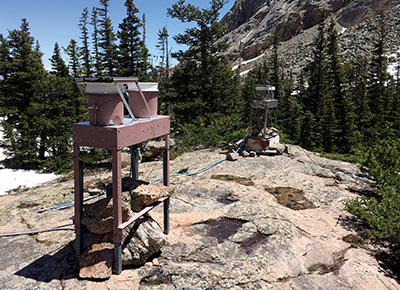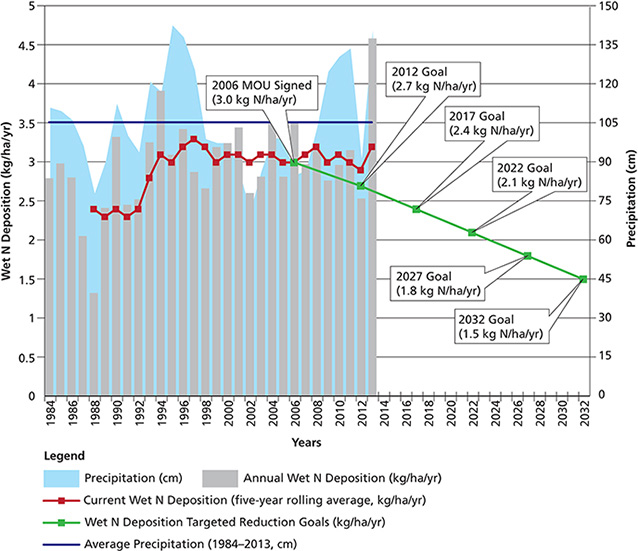Key words: cooperation, critical loads, nitrogen deposition, nitrogen deposition reduction plan, Rocky Mountain National Park
ROCKY MOUNTAIN NATIONAL PARK WAS CREATED 100 YEARS AGO “to preserve the high-elevation ecosystems and wilderness character of the southern Rocky Mountains” for the benefit and enjoyment of present and future generations (NPS 2013). It is home to protected alpine, subalpine, and montane ecosystems, but research has revealed that these ecosystems are sensitive to various forms of human disturbance, particularly the deposition of air pollutants. This form of pollution includes rain, snow, particles, and gases containing nitrogen (especially ammonium and nitrate) that cause acidification and nutrient enrichment of streams, lakes, vegetation, and soils. Nitrogen air pollution also contributes to haze in the park, which reduces visibility and obscures scenic views. Additionally, nitrogen oxides are components of ozone, a secondary pollutant that can affect human health and natural ecosystems. However, the focus of this discussion is nitrogen deposition in rain and snow and how it affects park ecosystems. This is a story of how state and federal agencies, and university researchers have partnered to collect air quality information and craft a policy approach to help protect the park’s air quality and high-elevation ecosystems from the threat caused by nitrogen deposition.
History of air pollution research and regulation in Rocky Mountain
In 1977, National Park Service managers were given an affirmative responsibility to protect air quality–related values in “Class 1” parks under the Clean Air Act amendments of 1977 (Public Law 95-95, 91 Statute 685). Once the park and its partners began to collect air quality information, park managers grew increasingly concerned about regional air pollution and specifically the effects of nitrogen deposition on high-elevation ecosystems. A national 10-year assessment (1980–1990) of the effects of nitrogen deposition on aquatic ecosystems by the National Acid Precipitation Assessment Program provided the backdrop for this concern (NAPAP 1990).

NPS/Kristi Morris
The National Park Service developed a research site in the park in 1982 to determine the effects of nitrogen deposition on a representative, high-elevation watershed ecosystem in the Colorado Front Range. Loch Vale watershed, which is located on the east side of the park in the alpine-subalpine backcountry at an elevation of 10,364 feet (3,159 meters), was equipped with research instruments more than 30 years ago (Baron 1992). Researchers have come to this watershed to monitor atmospheric nitrogen deposition in addition to climate, snowpack, streamflow, water chemistry, aquatic biota, soil chemistry, soil hydrology, and glaciers, with an emphasis on how atmospheric nitrogen deposition is affecting ecosystem processes at a watershed scale. Shortly after the watershed study began, the National Park Service installed a National Atmospheric Deposition Program/National Trends Network wet deposition monitoring site at Loch Vale watershed, Rocky Mountain National Park, to complement this ecosystem-level research (National Atmospheric Deposition Program 2014; fig. 1).
Once every week the National Park Service and its cooperators collect rain and snow samples at this site for chemical analysis. The park and its partners are committed to maintaining this long-term monitoring of wet deposition and have invested in the data collection for more than 32 years. The Loch Vale watershed study has evolved through time to include the current cooperative work among the U.S. Geological Survey, the National Park Service, and Colorado State University.

The persistence of the park and its research partners in collecting decades of data at Loch Vale has been key to understanding air quality effects in the park, and has allowed Rocky Mountain National Park to work with regulatory agencies to implement a long-term strategy to further define and then reduce atmospheric nitrogen deposition. Atmospheric transport research finds that emissions come from fossil fuel burning, auto emissions, crop production, and livestock production (Thompson et al. 2015; Benedict et al. 2013). Data collected in the park show that soils, water, vegetation, and diatom communities have been altered by increased nitrogen availability over the last 65 years (Baron 2006). The concept of “critical loads” of pollution, below which significant ecosystem effects do not occur, has been applied to data collected at Rocky Mountain National Park (Baron 2006). The estimated critical load for wet nitrogen deposition for alpine lakes in the Loch Vale watershed is 1.5 kilograms/hectare/year (kg/ha/yr) or 1.3 lb/ac/year. With these critical load estimates in hand, the Colorado Department of Public Health and Environment, the National Park Service, and the U.S. Environmental Protection Agency signed a memorandum of understanding (MOU) in 2006 and then developed the Rocky Mountain National Park Nitrogen Deposition Reduction Plan in 2007 (Colorado Department of Public Health and Environment et al. 2007). This partnership established a long-term goal for nitrogen wet deposition at Loch Vale of 1.5 kg/ha/yr (1.3 lb/ac/yr) by 2032, with proposed five-year milestones of nitrogen deposition reduction along a gradually declining linear path (fig. 2).
The Nitrogen Deposition Reduction Plan suggests that future nitrogen emission reductions will result from other control measures already in process (e.g., regional haze regulations). The 2007 plan suggests voluntary strategies to reduce nitrogen emissions, including possible measures to curb automobile emissions, reduce factory emissions, and implement agricultural best practices. A Nitrogen Deposition Contingency Plan was developed in 2010 to describe how the agencies should respond if the interim milestones are not achieved (Colorado Department of Public Health and Environment et al. 2010). This contingency plan calls for the following: (1) tracking of wet deposition of nitrogen compounds in Rocky Mountain National Park, (2) description of the process for triggering the development of contingency measures, (3) development of a list of potential contingency measures, and (4) provision for public outreach. It is important to note the language added to the MOU regarding imposition of additional nitrogen emission controls:
Nothing contained in this plan requires any entity, other than the above-mentioned agencies, to take any actions, or requires any entity to make enforceable emission reductions but does contemplate that the Colorado Air Quality Control Commission Subcommittee may be presented with future proposals to adopt enforceable requirements to reduce nitrogen deposition in the Park.
—Colorado Department of Public Health and Environment et al. 2007
The first nitrogen deposition milestone, set for 2012, was a five-year rolling average of 2.7 kg/ha/yr (2.4 lb/ac/yr) (Morris et al. 2015). The five-year average of 2.9 kg/ha/yr (2.6 lb/ac/yr) for 2008–2012, however, did not meet the goal. The 2013 monitoring and tracking report for wet nitrogen deposition at Rocky Mountain National Park notes an even higher five-year rolling average from 2009 to 2013 of 3.2 kg/ha/yr (2.9 lb/ac/yr), though this measurement was likely biased by large precipitation events in April and September 2013 (Morris et al. 2015). The partners agreed that current strategies need to have sufficient time to show effectiveness by the next milestone in 2017.
To aid in reducing ammonia emissions from farms and feedlots along the Front Range, the Colorado Department of Public Health and Environment, the National Park Service, Colorado State University, Texas A&M University, the Natural Resources Conservation Service, and the Colorado Livestock Association have designed a Web site that introduces the pilot project called the Rocky Mountain National Park Early Warning System (http://www.rmwarningsystem.com/EarlyWarnings.aspx). This Web site provides real-time information on weather conditions that would allow for the transport of agricultural emissions of ammonia from eastern Colorado upslope to Rocky Mountain National Park. This Web site recommends short-term management strategies to reduce ammonia emissions from animal and crop production. Use of online tools is voluntary at this time and should assist agricultural producers in reducing air emissions that result in increased nitrogen deposition in the park. Agricultural producers can use best management practices to reduce ammonia emissions from feedlots and dairy farms, and during fertilizer applications. However, Colorado regulators are limited by state law in requiring emission controls on agriculture (Porter and Johnson 2007). Another resource available to the agriculture industry is the Rocky Mountain National Park Agricultural Subcommittee, which was formed in 2006 to collaborate with the three agency partners and to provide recommendations for ammonia reduction strategies.
This air quality program at Rocky Mountain National Park represents a long-term commitment to protect the park’s ecosystems by using research, monitoring, and modelling to influence resource management in cooperation with agency partners and industry. This case study can be used as a model for other parks of how to link science to effective resource management through partnerships.
Literature cited
Baron, J. S. 2006. Hindcasting nitrogen deposition to determine an ecological critical load. Ecological Applications 16(2):433–439.
Baron, J. S., editor. 1992. Biogeochemistry of a subalpine ecosystem: Loch Vale watershed. Volume 90, Ecological Study Series. Springer-Verlag, New York, New York, USA.
Benedict, K. B., D. Day, F. M. Schwandner, S. M. Kreidenweis, B. Schichtel, W. C. Malm, and J. L. Collett Jr. 2013. Observations of atmospheric reactive nitrogen species in Rocky Mountain National Park and across northern Colorado. Atmospheric Environment 64:66–76.
Colorado Department of Public Health and Environment, National Park Service, and Environmental Protection Agency. 2007. Nitrogen Deposition Reduction Plan, Rocky Mountain National Park. Accessed 10 November 2015 from https://www.colorado.gov/pacific/sites/default/files/AP_PO_Nitrogen-Deposition-Reduction-Plan-NDRP.pdf.
———. 2010. Rocky Mountain National Park initiative: The Nitrogen Deposition Contingency Plan. Accessed 10 November 2015 from https://www.colorado.gov/pacific/sites/default/files/AP_PO_Nitrogen-Deposition-Reduction-Plan-NDRP-Contingency-Plan-Final-Version.pdf.
Morris, K., A. Mast, D. Clow, G. Wetherbee, J. Baron, C. Taipale, T. Blett, D. Gay, and D. Bowker. 2015. 2013 monitoring and tracking wet nitrogen deposition at Rocky Mountain National Park: July 2015. Natural Resource Report NPS/NRSS/ARD/NRR–2015/997. National Park Service, Fort Collins, Colorado, USA.
National Acid Precipitation Assessment Program (NAPAP). 1990. Acid deposition: State of science and technology. Volume II: Aquatic processes and effects. National Acid Precipitation Assessment Program, Office of the Director, Washington, D.C., USA.
National Atmospheric Deposition Program. 2014. NTN Site CO98. Accessed 7 October 2015 from http://nadp.sws.uiuc.edu/data/sites/siteDetails.aspx?net=NTN&id=CO98.
National Park Service (NPS). 2013. Foundation document: Rocky Mountain National Park, Colorado. U.S. Department of the Interior, National Park Service, Rocky Mountain National Park, Estes Park, Colorado, USA.
Porter, E., and S. Johnson. 2007. Translating science into policy: Using ecosystem thresholds to protect resources in Rocky Mountain National Park. Environmental Pollution 149:268–280.
Thompson, T. M., M. A. Rodriguez, M. G. Barna, K. A. Gebhart, J. L. Hand, D. E. Day, W. C. Malm, K. B. Benedict, J. L. Collett, and B. A. Schichtel. 2015. Rocky Mountain National Park reduced nitrogen source apportionment. Journal of Geophysical Research: Atmospheres 120:4370–4384.
About the author
Kathy Tonnessen, is National Park Service scientist emeritus and affiliate faculty at the University of Montana, Missoula.
Download: PDF of this article
This article published
Online: 6 May 2016; In print: 25 March 2016
URL
https://www.nps.gov/ParkScience/articles/parkscience32_2_tonnessen_3842.htm
Suggested citation
Tonnessen, K. 2016. High elevations under threat from nitrogen deposition: Air quality monitoring, research, and management at Rocky Mountain National Park. Park Science 32(2):73–75.
This page updated
5 May 2016
Site navigation
• Back to Volume 32, Number 2
• Back to Park Science home page
Last updated: December 1, 2020
